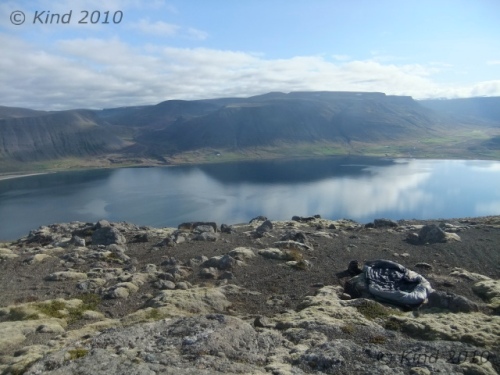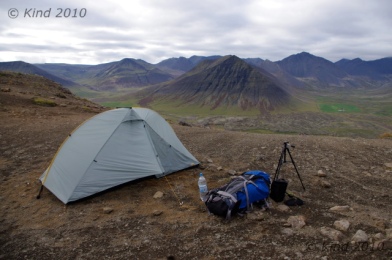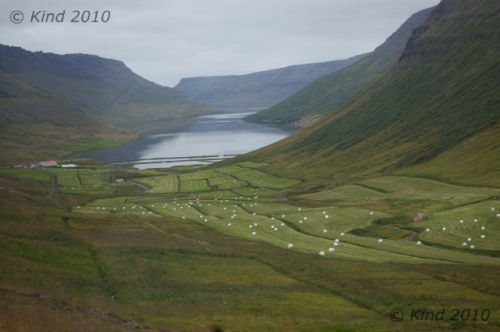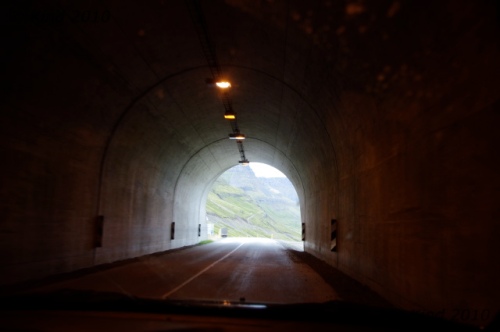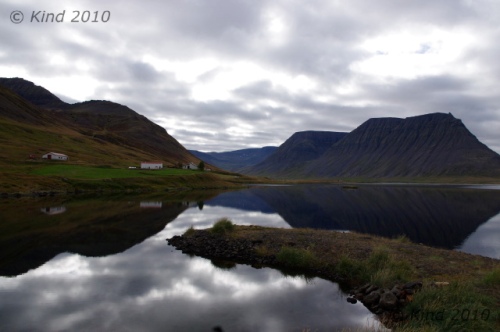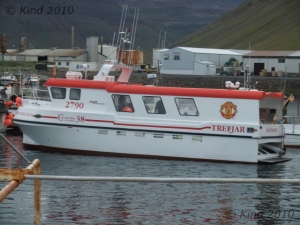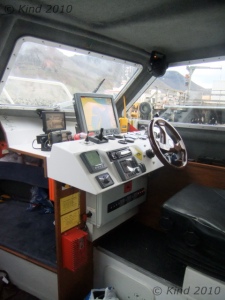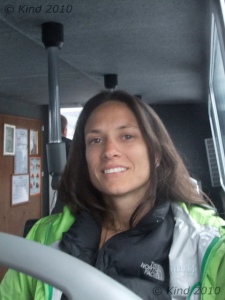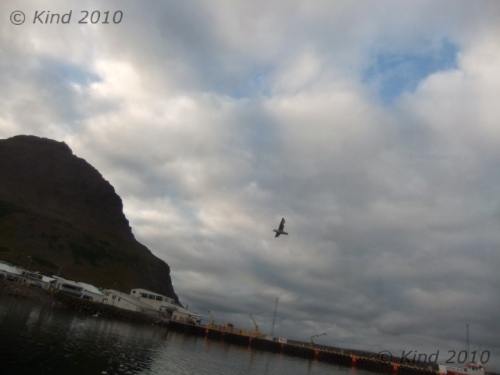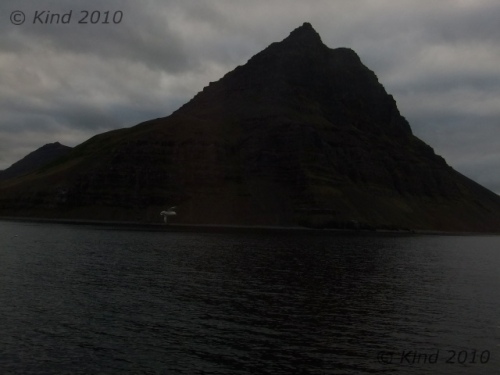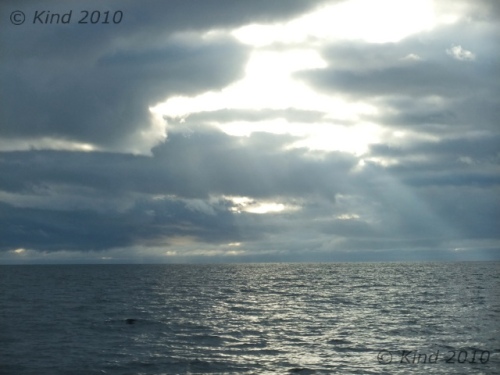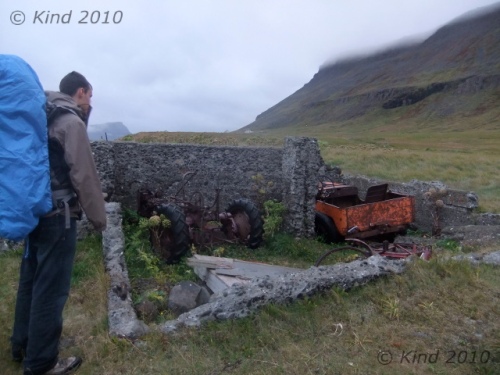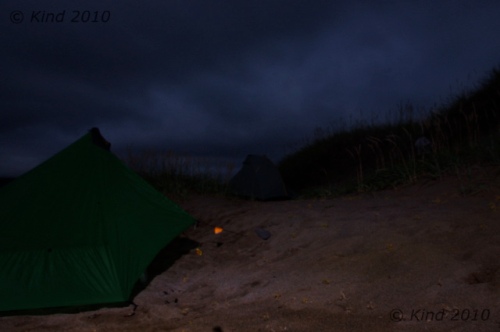 Despite staying up with the Northern Lights, we woke at 7am to break camp. We headed southeast around Snæfellsnes peninsula to approach Snæfellsjökull from the south (again). On a tightly planned schedule for the day (never a great idea), we made a quick stop at the little (300m) volcanic caldera Saxhóll. I sprinted to the top, up and down, back on the main road in 15 minutes. I thought my heart would burst, but it was worth the run.
Despite staying up with the Northern Lights, we woke at 7am to break camp. We headed southeast around Snæfellsnes peninsula to approach Snæfellsjökull from the south (again). On a tightly planned schedule for the day (never a great idea), we made a quick stop at the little (300m) volcanic caldera Saxhóll. I sprinted to the top, up and down, back on the main road in 15 minutes. I thought my heart would burst, but it was worth the run.
 As we rounded Snæfell from the south in brilliant sunshine- another perfectly gorgeous day- we had to stop to take a picture of the unique ripples in the grey mountain side on our left. The spot we pulled over had a little path that led to a hollow with a spiral staircase disappearing into the ground!
As we rounded Snæfell from the south in brilliant sunshine- another perfectly gorgeous day- we had to stop to take a picture of the unique ripples in the grey mountain side on our left. The spot we pulled over had a little path that led to a hollow with a spiral staircase disappearing into the ground!
This just happened to be Vatnshellir, a 100m long cave formed in the lava 8000 years ago. Access was denied to random tourists without a guide (atypical for Iceland’s tourist philosophy, but probably very appropriate), and the steel silo housing the staircase was all locked up.
We could still see down into the railed viewing hole, and the air coming from it was cold and smelled like winter.
I believe we were near Lóndrangar.
 A little farther down the road we stopped for the columns of rock we could see rising from the horizon against the sea on our right.
A little farther down the road we stopped for the columns of rock we could see rising from the horizon against the sea on our right.
Walking up and out to the cliffs, we saw an arctic fox running across the field below us, and hung out on the cliff edge high above the surf breaking on the black rocks below us. Birds were sailing around on the updrafts. I was already loving the bluntnosed guillemots, ubiquitous but cute and bright white.

 After walking around for some time, perching on the edge, and taking vertiginous birds-eye shots of the birds swooping in the drafts, my brother found a warning on a post.
After walking around for some time, perching on the edge, and taking vertiginous birds-eye shots of the birds swooping in the drafts, my brother found a warning on a post.
“Oh, here’s a sign!” he called out. A little 4 x 4” sign on a post, floating out there in the field of gently waving grass. Watch out for the cliff!
 On to Arnarstapi and the “must-do” seaside walk to Hellnar. The beginning of the hike at Arnarstapi is guarded by an impressive stacked rock sculpture – Baldur of the Sagas.
On to Arnarstapi and the “must-do” seaside walk to Hellnar. The beginning of the hike at Arnarstapi is guarded by an impressive stacked rock sculpture – Baldur of the Sagas.
As we walked the winding path along the black basalt cliffs (close the gate behind you to keep the sheep out!), we tried over and over to capture the swooping seabirds in our shots.
This place was gorgeous, with the radiating patterns of basalt columns forming caves, ends rounded by the waves.
The sun was shining brightly off the water and the oil-black diving birds clustered on the black rocks, against the deep blue Atlantic and green grass topping the cliffs.
From there we drove up the mountain, stopping en route at Sönghellir, one of Iceland’s singing caves. This was the most magic place ever, the second place so far that I felt powerfully the magic of the earth.
 It’s called a singing cave because of the acoustic resonance, how sounds inside vibrate and shimmer. I crawled up the curving shelves in the wall of the cave and settled in there, watching tourists below me coming and going without ever seeing me. Dozens of them strode in, nattering the whole time: “Oh, here it is…It’s not very big…My flash isn’t working…What’s next, honey?” I was amazed and appalled that they weren’t all struck with awe, considering how the place made my spine tingle and made me want to fall to my knees. I couldn’t leave, going into the cave again and again, singing,
It’s called a singing cave because of the acoustic resonance, how sounds inside vibrate and shimmer. I crawled up the curving shelves in the wall of the cave and settled in there, watching tourists below me coming and going without ever seeing me. Dozens of them strode in, nattering the whole time: “Oh, here it is…It’s not very big…My flash isn’t working…What’s next, honey?” I was amazed and appalled that they weren’t all struck with awe, considering how the place made my spine tingle and made me want to fall to my knees. I couldn’t leave, going into the cave again and again, singing,  and clambering around the general vicinity until I felt I’d adequately communicated with the spirit force in that cave.
and clambering around the general vicinity until I felt I’d adequately communicated with the spirit force in that cave.
In the parking “lot”/patch of gravel, it was so windy I grabbed the opportunity to dry out our tents that we’d rolled up still wet with dew. One tent at a time billowed out like a sail and dried in seconds.

 The gravel road up to the jökull was a steady ascent in a rust coloured wasteland moderated by moss and lichen. We stopped several times to take pictures of the developing southward view behind us, and to dry out the second tent. The view was breathtakingly expansive, of the ocean, that sandar, and a fascinating mountain- Stapafell.
The gravel road up to the jökull was a steady ascent in a rust coloured wasteland moderated by moss and lichen. We stopped several times to take pictures of the developing southward view behind us, and to dry out the second tent. The view was breathtakingly expansive, of the ocean, that sandar, and a fascinating mountain- Stapafell.
Giants are said to have populated this area in the past, hence the rock monument at Arnarstapi to the last giant, and the cairn atop Stapafell rather corroborates that as a literal possibility. The spike on Stapafell’s peak looks exactly like the other rock cairns speckling Iceland, but it’s HUGE. No humans hiked those rocks up there; there’s no way. I didn’t find any commentary on it, but it’s surely not naturally occurring, and it’s too massive to be human-made. It’s a mystery.
We were spectacularly lucky to see the glacier at all. Snæfellsjökull is notorious for being cloaked in clouds 90% of the time, like it was last night. But the day was still clear and cloudless, and we quickly made the short climb to see the jökull up close – as close as one can without a special guide or pass to get on the glacier. The ice was close, we could feel it. Quite nippy on the top of the hill.
 Our schedule revolved around catching a twice per day ferry at Stykkishólmur for the Westfjords that afternoon, so we headed down the north side of the peninsula from the mountain with a mission to cover ground quick. We stopped at Kirkufell to see some sheep hanging out in the low surf and seaweed – clearly sheep are truly everywhere they’re not fenced out of in Iceland, and to pick up our first hitchhiker. Of course, she was Canadian. Not only that, but she was from Vancouver, and it took us about four minutes to establish one degree of separation. So we practically knew each other already, having just met in Nowhere, Iceland.
Our schedule revolved around catching a twice per day ferry at Stykkishólmur for the Westfjords that afternoon, so we headed down the north side of the peninsula from the mountain with a mission to cover ground quick. We stopped at Kirkufell to see some sheep hanging out in the low surf and seaweed – clearly sheep are truly everywhere they’re not fenced out of in Iceland, and to pick up our first hitchhiker. Of course, she was Canadian. Not only that, but she was from Vancouver, and it took us about four minutes to establish one degree of separation. So we practically knew each other already, having just met in Nowhere, Iceland.
We had the same destination, Stykkishólmur, but we were headed for the Baldur ferry and she was undecided about going to the Westfjords. On the drive, we stopped at the “Lonely Planet notable destination” of Helgafell, where you may be granted three wishes if you follow the correct process of climbing the hill to the chapel ruins from the grave of Guðrún Ósvífursdóttir. This was a lovely, serene place, overlooking green squares of fields.
 At Stykkishólmur, we bought our passage on the ferry, Cheryl still undecided, and then sped off for the ultrafast tour of Stykkishólmur. My credit card decided to work again for the tickets, happily. Ignoring the problem seemed to work. We had been hoping to stop in at the swimming pool for a soak and to clean up before heading into the remote Westfjords, but that was out of the question with under an hour before sailing. We rapidly took in the church, Stykkishólmskirkja, as distinctive as all Icelandic kirkjas, but towering and majestic. The bell tower was receiving some kind of industrial attention at the time.
At Stykkishólmur, we bought our passage on the ferry, Cheryl still undecided, and then sped off for the ultrafast tour of Stykkishólmur. My credit card decided to work again for the tickets, happily. Ignoring the problem seemed to work. We had been hoping to stop in at the swimming pool for a soak and to clean up before heading into the remote Westfjords, but that was out of the question with under an hour before sailing. We rapidly took in the church, Stykkishólmskirkja, as distinctive as all Icelandic kirkjas, but towering and majestic. The bell tower was receiving some kind of industrial attention at the time.
We had more trouble finding the Library of Water, but it was worth it. The minimalist art installation in a former library – I missed the “former” and was expecting art and books – was an irregularly shaped room with two dozen acrylic columns filled with water, and a rubber floor with words stuck on it. 
We had to trade our shoes for very unphotogenic white slippers to walk on the sensitive floor, but the place was a kind of high-brow funhouse, with the columns of water refracting the views out the windows and of each other as we walked among them. At the last minute we ran (quite literally) out with our shoes untied, leapt back into the car and sped down to the ferry landing again.
Cheryl decided to stay with us for at least a day, and she dashed out to buy her ticket as cars began to roll onto the ferry. So now we were three.
The ferry was shockingly slow. For a 25km crossing, it took two and a half hours! We were not expecting that much time in the least. I suppose it was an older boat, with a closed car deck that you couldn’t stay on during passage. Luckily, I snatched my laptop off the car deck at the Flatey stop, and we tanked up on fries and skyr at the cafeteria. Mid-trip, the ferry docks for a moment at Flatey, a tiny island that you can see the whole of from the boat. Everyone was crowded around that side of the boat to see the island, and a big ruckus broke out. The ferry pulled away from the dock to leave, then reversed hard and docked again, as a man dressed like the captain, or maybe first mate, descended from the tower and much hollering burst out in Icelandic. Nothing was unloaded or reloaded, though, and the ferry departed again.
 The Baldur ferry is one of two ways onto the Westfjords – the large northwestern peninsula that looks like the head of the creature-like shape of Iceland overall. The other way is to drive there, through the neck, which means much purportedly less interesting driving. The ferry gets you to the interesting parts faster, supposedly, with an Atlantic Ocean boat ride thrown in. The ride was bracingly windy and salt-sprayed, with a large outdoor deck close to the surface of the water. It was a gorgeous day – our luck continued – and it was lovely to be outside in the mixture of sun warm and wind cold.
The Baldur ferry is one of two ways onto the Westfjords – the large northwestern peninsula that looks like the head of the creature-like shape of Iceland overall. The other way is to drive there, through the neck, which means much purportedly less interesting driving. The ferry gets you to the interesting parts faster, supposedly, with an Atlantic Ocean boat ride thrown in. The ride was bracingly windy and salt-sprayed, with a large outdoor deck close to the surface of the water. It was a gorgeous day – our luck continued – and it was lovely to be outside in the mixture of sun warm and wind cold.
 We were heading to the Westfjords to go hiking and camping in the lesser-seen Hornstrandir, the uninhabited nature preserve at the northwesternmost tip. For this first night, though, we were headed directly for Latraberg, one of several famous bird cliffs. We stopped to tank up at the one-pump, last chance station, where everyone else off the ferry was also stopping. We had to wait for another couple to finish filling before we could, and it turned out they were Canadian too. After I paid and came back out, putting away my credit card, I heard the next couple pumping gas talking, and they were also Canadian! All the Canadians we’d met so far on this trip, all in the same day! I started talking to them, and she said, “Well, apparently only 3% of all the tourists who visit Iceland come to the Westfjords. I guess that’s all the Canadians”.
We were heading to the Westfjords to go hiking and camping in the lesser-seen Hornstrandir, the uninhabited nature preserve at the northwesternmost tip. For this first night, though, we were headed directly for Latraberg, one of several famous bird cliffs. We stopped to tank up at the one-pump, last chance station, where everyone else off the ferry was also stopping. We had to wait for another couple to finish filling before we could, and it turned out they were Canadian too. After I paid and came back out, putting away my credit card, I heard the next couple pumping gas talking, and they were also Canadian! All the Canadians we’d met so far on this trip, all in the same day! I started talking to them, and she said, “Well, apparently only 3% of all the tourists who visit Iceland come to the Westfjords. I guess that’s all the Canadians”.
 The road out towards Patreksfjorður was another contender for world’s worst road. Paved with rugged 3” gravel, it was a very slow, teeth rattling ride. As the road curled around the point and descended into a tiny hamlet of four or so houses, the beach stretched out long and bumpy with grassy hummocks, dotted with a few sheep. We stopped to watch the sunset and wander on the beach. As night fell we decided to just camp there next to the road. The beach was tangled with seaweed, swampy in places, and the sheep were shy. But the usual Inspirational Calendar sunset bloomed over the water, changing by the moment, and then, as the sun fell, we spotted the most mysterious line of bright pink chunks of light on the distant horizon.
The road out towards Patreksfjorður was another contender for world’s worst road. Paved with rugged 3” gravel, it was a very slow, teeth rattling ride. As the road curled around the point and descended into a tiny hamlet of four or so houses, the beach stretched out long and bumpy with grassy hummocks, dotted with a few sheep. We stopped to watch the sunset and wander on the beach. As night fell we decided to just camp there next to the road. The beach was tangled with seaweed, swampy in places, and the sheep were shy. But the usual Inspirational Calendar sunset bloomed over the water, changing by the moment, and then, as the sun fell, we spotted the most mysterious line of bright pink chunks of light on the distant horizon.
They were bright, they were pink, and most mysteriously, they stayed there, illuminated long after the sun set. We just couldn’t figure out what they were. They were too far too see distinctly, on the edge of distance where your eyes throb with the effort of focusing. But Derek took dozens of pictures and zoomed in on those, and we speculated what they could possibly be. They must have been ice, to be so reflective. Icebergs seemed most likely, but the light reflected from them was so strong it seemed they must be bigger than that, and they didn’t move in the least, even as the hours passed. Someone said “Greenland!” and that seemed like the answer. We were standing on the westernmost point of the westernmost tongue of land on Iceland, the closest one can possibly be to Greenland while in Iceland, although it’s still 300km away.
 Long after we made supper, set up our three tents, and let tiredness close the day, the pink mystery still glowed faintly on the horizon.
Long after we made supper, set up our three tents, and let tiredness close the day, the pink mystery still glowed faintly on the horizon.
We asked over the next few days about the horizon iceberg/Greenland phenomenon, and were told it was impossible to see Greenland, even from the highest point of Iceland, certainly not from sea level. I frowned at this. I know what I saw. After we got home though, Google answered the question for good. It is indeed impossible to see Greenland because of the curvature of the Earth, but there is an optical phenomenon called a fata morgana, or “hafgerdingar” in Icelandic, that bends light rays in different temperature air, especially in polar regions.
For more photos of this day in Iceland, visit the Extra Photos page.




















